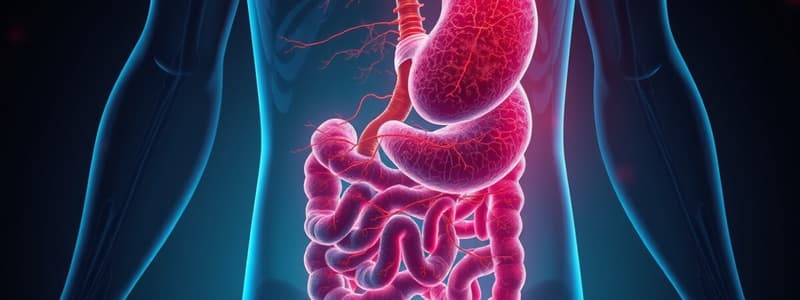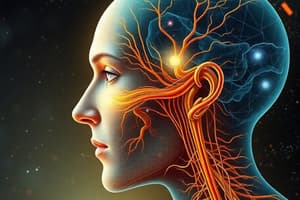Podcast
Questions and Answers
What is the primary mechanism by which water is absorbed in the small intestine?
What is the primary mechanism by which water is absorbed in the small intestine?
- Simple diffusion
- Facilitated diffusion
- Active transport
- Osmosis (correct)
Which enzyme is specifically responsible for splitting lactose into glucose and galactose?
Which enzyme is specifically responsible for splitting lactose into glucose and galactose?
- Maltase
- Lactase (correct)
- Sucrase
- Alpha-dextrinase
What is the purpose of the peristaltic rush in the small intestine?
What is the purpose of the peristaltic rush in the small intestine?
- To expel irritative chyme and relieve distention (correct)
- To promote secretion of digestive enzymes
- To enhance nutrient absorption
- To move chyme slowly for better digestion
Which method is used for the absorption of fructose in the small intestine?
Which method is used for the absorption of fructose in the small intestine?
Which statement correctly describes the absorption of sodium in the small intestine?
Which statement correctly describes the absorption of sodium in the small intestine?
What type of secretion do the parotid glands produce?
What type of secretion do the parotid glands produce?
Which ion is found in larger quantities in saliva compared to others?
Which ion is found in larger quantities in saliva compared to others?
What is the primary digestive function of ptyalin in saliva?
What is the primary digestive function of ptyalin in saliva?
What substance in saliva helps to maintain oral hygiene?
What substance in saliva helps to maintain oral hygiene?
During which stage of swallowing does voluntary control occur?
During which stage of swallowing does voluntary control occur?
What muscle action is primarily engaged by the jaw muscles during chewing?
What muscle action is primarily engaged by the jaw muscles during chewing?
What defines the pharyngeal stage of swallowing?
What defines the pharyngeal stage of swallowing?
What type of peristalsis is primarily involved in the initial movement of food through the esophagus?
What type of peristalsis is primarily involved in the initial movement of food through the esophagus?
Which enzyme is responsible for the digestion of fats after emulsification?
Which enzyme is responsible for the digestion of fats after emulsification?
What is the primary role of the ileocecal valve within the digestive system?
What is the primary role of the ileocecal valve within the digestive system?
Which of the following compounds are primarily produced in the large intestine?
Which of the following compounds are primarily produced in the large intestine?
What type of reflex is involved in the intrinsic defecation process?
What type of reflex is involved in the intrinsic defecation process?
Through which mechanism are dipeptides and tripeptides absorbed in the digestive system?
Through which mechanism are dipeptides and tripeptides absorbed in the digestive system?
Mass movements in the colon are characterized by which of the following?
Mass movements in the colon are characterized by which of the following?
What is the primary function of the upper part of the colon?
What is the primary function of the upper part of the colon?
Which digestive enzyme acts on disaccharides in the intestine to produce simpler sugars?
Which digestive enzyme acts on disaccharides in the intestine to produce simpler sugars?
Which cranial nerve provides parasympathetic innervation to the gut?
Which cranial nerve provides parasympathetic innervation to the gut?
What is the frequency of slow waves in the duodenum?
What is the frequency of slow waves in the duodenum?
Which of the following is NOT a functional type of movement in the gastrointestinal tract?
Which of the following is NOT a functional type of movement in the gastrointestinal tract?
What initiates spike potentials in gastrointestinal smooth muscle?
What initiates spike potentials in gastrointestinal smooth muscle?
Which part of the gastrointestinal tract has the highest frequency of slow waves?
Which part of the gastrointestinal tract has the highest frequency of slow waves?
What primarily stimulates the gastrointestinal tract's mixing movements?
What primarily stimulates the gastrointestinal tract's mixing movements?
The law of the gut states that ingestion of food is primarily determined by which intrinsic desire?
The law of the gut states that ingestion of food is primarily determined by which intrinsic desire?
Which glands are principal in the secretion of saliva?
Which glands are principal in the secretion of saliva?
What is the primary consequence of damage to the cranial nerves involved in the swallowing mechanism?
What is the primary consequence of damage to the cranial nerves involved in the swallowing mechanism?
Which condition is characterized by the failure of the lower esophageal sphincter to relax during swallowing?
Which condition is characterized by the failure of the lower esophageal sphincter to relax during swallowing?
What is a common symptom of appendicitis?
What is a common symptom of appendicitis?
Which of the following is NOT typically a cause of peptic ulcers?
Which of the following is NOT typically a cause of peptic ulcers?
What causes gastritis?
What causes gastritis?
In which condition would you expect to find achlorhydria?
In which condition would you expect to find achlorhydria?
What type of cell in the small intestine is responsible for the absorption of water and electrolytes?
What type of cell in the small intestine is responsible for the absorption of water and electrolytes?
Which of the following is a symptom of failure of the glottis to close during swallowing?
Which of the following is a symptom of failure of the glottis to close during swallowing?
Flashcards are hidden until you start studying
Study Notes
Parasympathetic and Sympathetic Nervous Supply to the Gut
- Cranial supply comes from the Vagus nerve (10th cranial), providing innervation to the esophagus, stomach, pancreas, and first half of the large intestine.
- Sacral supply originates from the 2nd, 3rd, and 4th spinal pelvic nerves, helping execute defecation reflexes.
- Parasympathetic stimulation increases the overall activity of the enteric nervous system.
- Sympathetic fibers arise from T5 to L2 spinal cord segments and inhibit gastrointestinal (GIT) activity.
Electrical Activity of GIT Smooth Muscle
- Slow Waves (Basic Electrical Rhythm - BER):
- Generated by Na-K pump activity; frequency differs in GIT regions:
- 3/min in stomach
- 12/min in duodenum
- 8-9/min in terminal ileum
- Generated by Na-K pump activity; frequency differs in GIT regions:
- Spike Potentials:
- True action potentials occurring when resting membrane potential exceeds -40 mV; triggered by slow Ca-Na channel opening, leading to muscle contraction and peristalsis.
Functional Types of Movement in the GIT
- Mixing Movements: GIT continuously mixes contents by peristaltic or local constrictive contractions.
- Propulsive Movement: Advances food through the digestive tract.
- Peristalsis: Key propulsive movement stimulated by the myenteric plexus, irritants, or extrinsic nervous signals.
Law of the Gut
- Ingestion driven by hunger (intrinsic desire) and appetite (food preference).
- Saliva, rich in amylase (ptyalin), begins starch digestion upon food entry in the mouth.
Secretion of Saliva
- Major glands: Parotid, Submandibular, and Sublingual; small Buccal glands also present.
- Saliva contains two primary proteins:
- Serous Secretion: Contains ptyalin for starch digestion.
- Mucous Secretion: Contains mucin for lubrication.
- Saliva composition: high in potassium and bicarbonate, low in sodium and chloride.
Functions of Saliva
- Mechanical Functions: Moistens mouth, aids in speech and mastication, and protects mucous membranes.
- Digestive Functions: Ptyalin breaks down starch into maltose.
- Excretory Functions: Eliminates urea, heavy metals, and other substances.
- Oral Hygiene: Washes away bacteria and food particles, contains bactericidal thiocyanate and enzymes.
Mastication and Swallowing (Deglutition)
- Mastication: Utilizes molars for grinding, incisors for cutting; muscles exert about 55 pounds of force.
- Swallowing Stages:
- Voluntary Stage: Initiates swallowing.
- Pharyngeal Stage: Involuntary; involves nasopharynx, oropharynx, and laryngopharynx; regulated by pharyngoesophageal sphincter.
- Esophageal Stage: Promotes food passage using primary and secondary peristalsis.
Peristaltic Rush
- Rapid peristalsis in the small intestine due to mucosal irritation, aiming to expel irritative chyme and reduce distension.
- Triggered by autonomic nervous reflexes and intrinsic myenteric reflexes.
Enzymes in Small Intestinal Secretions
- Secreted by epithelial cells in the intestinal mucosa, crucial for nutrient absorption:
- Enterokinase activates proteolytic enzymes: Aminopolypeptidase, Dipeptides.
- Carbohydrate Enzymes: Lactase, Sucrase, Maltase, Alpha-dextrinase.
Absorption in the GIT
- Water Absorption: 99% occurs by osmosis.
- Sodium: Absorbed (25-35 gm/day) through active transport and diffusion.
- Ion Absorption: Active transport for Ca, Fe; Na-glucose co-transport for glucose and galactose; facilitated diffusion for fructose.
- Protein Absorption: Amino acids via sodium-cotransport and larger peptides by pinocytosis.
Digestion of Nutrients
- Starches: Broken down by enzymes from saliva and pancreatic amylase.
- Fats: Emulsified by bile and digested by pancreatic lipase.
- Proteins: Protein digestion initiated by pepsin, followed by trypsin, chymotrypsin, and carboxypeptidase.
Ileocecal Valve
- Prevents retrograde flow of fecal matter from the colon into the small intestine; withstands reverse pressures of 50-60 cm H2O.
Functions and Movements of the Colon
- Absorbs water and electrolytes, forming feces in the upper part; stores fecal matter in the lower part.
- Movements classified as:
- Mixing movements (Haustration)
- Propulsive movements (Mass Movements) that occur during distension or irritation.
Defecation
- Internal Anal Sphincter: Involuntary control, smooth muscle.
- External Anal Sphincter: Voluntary control, striated muscle.
- Types of defecation reflex include intrinsic reflexes and those influenced by the autonomic nervous system.
GIT Pathophysiology
- Dysphagia Causes: Damage to cranial nerves, neurological disorders, or muscular atrophy affecting swallowing.
- Gastritis: Inflammation of gastric mucosa from various irritants.
- Peptic Ulcer: Excoriations in mucosa due to excess gastric acid and stress factors.
- Appendicitis: Infection-causing inflammation; symptoms include abdominal pain and intestinal obstruction.
Studying That Suits You
Use AI to generate personalized quizzes and flashcards to suit your learning preferences.


